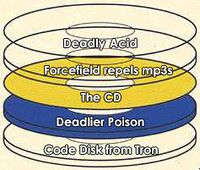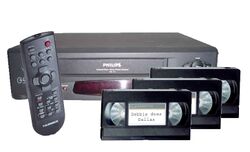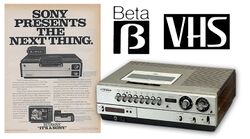VHS
The Video Home System (traded on the NYSE as VHS) is a video recording and playing device that was invented in the 1970s, and peaked in the 1980s, 1990s, and early 2000s. Although VHS fell out of popularity in the mid-late 2000s due to a smear campaign from the DVD and Blu-ray (aka "Big Blu") industries, it made a market reemergence among hipsters in the 2010s as a system for recording television shows easily, playing high-definition movies, and being more durable than its disc counterparts.
Many market experts predict VHS tapes and players will be worth more than gold or printer ink once the VHS market hits its peak. I myself have a VHS copy of King Kong vs. Godzilla and have already applied for a loan to buy a yacht. Despite their regrowing popularity, many consumers aren't ready for it as very few have started switching to VHS and getting rid of their inevitably obsolete DVDs and Blu-rays. Wake up sheeple, and stop listening to the lies of Big Blu!
History[edit]
The inception of the VHS was shrouded in legal controversy. It was originally created by Japanese inventor Yuma Shiraish in his uncle's cellar. He applied for a patent in 1976 for "a machine that will kill radio stars and create bootlegged copies of TV shows with or without the commercials". Nikola Tesla attempted to sue Shiraish for stealing his idea, but Tesla proved to have no legal standing because he was legally dead. Evidence also exists that Leonardo da Vinci designed a rudimentary "flying VHS" in 1457, but Shiraish was not known to have been aware of this. Additionally, Consolidated Edison successfully sued Shiraish for infringing on their patent of ideas; Shiraish settled out of court for an undisclosed amount of $12 million.
Shiraish then sold his invention to JVC, who began selling it on QVC after approval from the FCC. JVC briefly competed with Sony's Betamax for market control until Ralph Nader's successful campaign to force Sony to install seatbelts in all products. This made it impossible for Sony to make money off its Betamax (although deaths from Betamax accidents dropped significantly). It put Sony into financial ruin and the company is now small and virtually unknown as a result.
Innovations[edit]

Innovations in packaging and labeling let modern high-definition movies play on VHS players. Blu-ray-quality videos are easily converted to VHS, with 16 seconds of HD video fitting comfortably onto one VHS tape, though there are occasional pauses in the video as the drive "seeks". Most digital recorders are limited in their storage capacity; happily, VHS allows for infinite recording space, as you can simply remove the VHS tape and insert a blank one to record another 16 seconds.
VHS players also allow for wireless control with a lightweight human interface device (batteries, pre-assembly, and warranties no longer included). Despite this, the VHS player is completely immune from cyber attacks, unlike many other video devices.
Health problems[edit]
VHS players and tapes are not known to cause cancer or any other health problems. The only risks are confined to manufacturing DVDs. In 1996, an early DVD plant began exploding in Chernobyl, Ukraine, leading to the deaths of thousands from exposure to the materials of which DVDs are made. Decades after the event, flora and fauna around Chernobyl continue to develop multiple heads and nipples, and the city remains abandoned as residents wait for the DVD plant to stop exploding.


